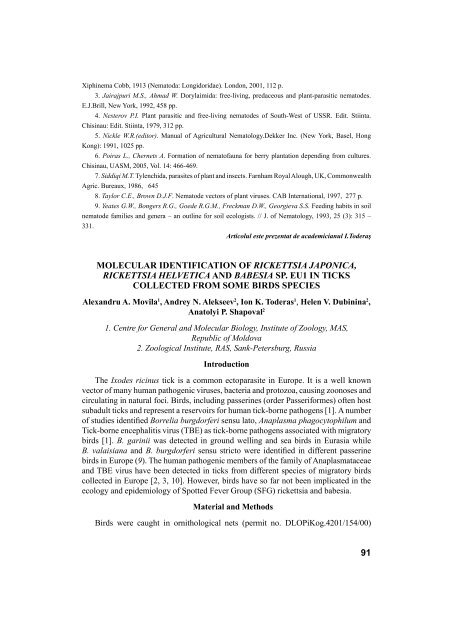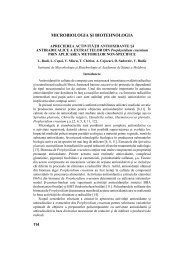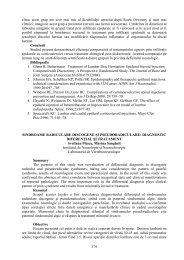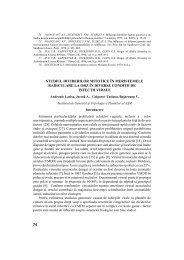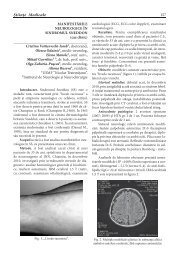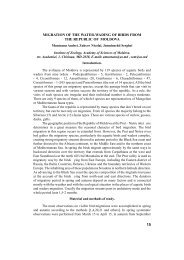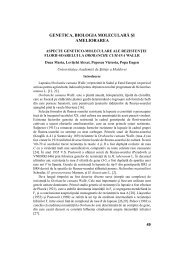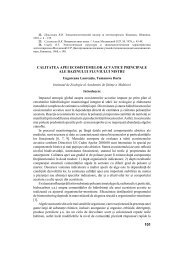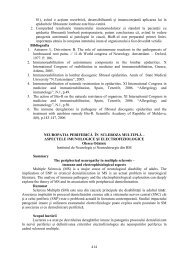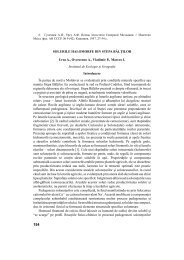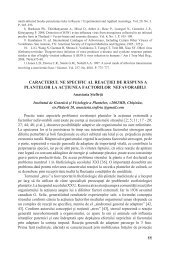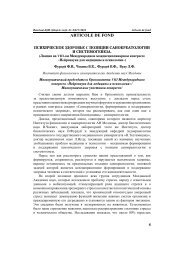198 CUPRINS
198 CUPRINS
198 CUPRINS
Create successful ePaper yourself
Turn your PDF publications into a flip-book with our unique Google optimized e-Paper software.
Xiphinema Cobb, 1913 (Nematoda: Longidoridae). London, 2001, 112 p.<br />
3. Jairajpuri M.S., Ahmad W. Dorylaimida: free-living, predaceous and plant-parasitic nematodes.<br />
E.J.Brill, New York, 1992, 458 pp.<br />
4. Nesterov P.I. Plant parasitic and free-living nematodes of South-West of USSR. Edit. Stiinta.<br />
Chisinau: Edit. Stiinta, 1979, 312 pp.<br />
5. Nickle W.R.(editor). Manual of Agricultural Nematology.Dekker Inc. (New York, Basel, Hong<br />
Kong): 1991, 1025 pp.<br />
6. Poiras L., Chernets A. Formation of nematofauna for berry plantation depending from cultures.<br />
Chisinau, UASM, 2005, Vol. 14: 466-469.<br />
7. Siddiqi M.T. Tylenchida, parasites of plant and insects. Farnham Royal Alough, UK, Commonwealth<br />
Agric. Bureaux, <strong>198</strong>6, 645<br />
8. Taylor C.E., Brown D.J.F. Nematode vectors of plant viruses. CAB International, 1997, 277 p.<br />
9. Yeates G.W., Bongers R.G., Goede R.G.M., Freckman D.W., Georgieva S.S. Feeding habits in soil<br />
nematode families and genera – an outline for soil ecologists. // J. of Nematology, 1993, 25 (3): 315 –<br />
331.<br />
Articolul este prezentat de academicianul I.Toderaş<br />
MOLECULAR IDENTIFICATION OF RICKETTSIA JAPONICA,<br />
RICKETTSIA HELVETICA AND BABESIA SP. EU1 IN TICKS<br />
COLLECTED FROM SOME BIRDS SPECIES<br />
Alexandru A. Movila 1 , Andrey N. Alekseev 2 , Ion K. Toderas 1 , Helen V. Dubinina 2 ,<br />
Anatolyi P. Shapoval 2<br />
1. Centre for General and Molecular Biology, Institute of Zoology, MAS,<br />
Republic of Moldova<br />
2. Zoological Institute, RAS, Sank-Petersburg, Russia<br />
Introduction<br />
The Ixodes ricinus tick is a common ectoparasite in Europe. It is a well known<br />
vector of many human pathogenic viruses, bacteria and protozoa, causing zoonoses and<br />
circulating in natural foci. Birds, including passerines (order Passeriformes) often host<br />
subadult ticks and represent a reservoirs for human tick-borne pathogens [1]. A number<br />
of studies identi ed Borrelia burgdorferi sensu lato, Anaplasma phagocytophilum and<br />
Tick-borne encephalitis virus (TBE) as tick-borne pathogens associated with migratory<br />
birds [1]. B. garinii was detected in ground welling and sea birds in Eurasia while<br />
B. valaisiana and B. burgdorferi sensu stricto were identi ed in different passerine<br />
birds in Europe (9). The human pathogenic members of the family of Anaplasmataceae<br />
and TBE virus have been detected in ticks from different species of migratory birds<br />
collected in Europe [2, 3, 10]. However, birds have so far not been implicated in the<br />
ecology and epidemiology of Spotted Fever Group (SFG) rickettsia and babesia.<br />
Material and Methods<br />
Birds were caught in ornithological nets (permit no. DLOPiKog.4201/154/00)<br />
91


